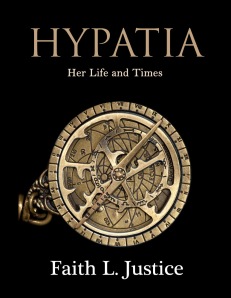
Historian’s Notebook has moved. Details here.
It’s Women’s History Month, so here’s another Hypatia article! I’ve posted several in the past two years and put this one off, because it’s such a tricky one. As anyone who has studied Hypatia knows, there is little out there in the way of primary sources. Only a few pages come down to us from those times and almost none can be attributed to Hypatia, except a couple of technical works on mathematics and astronomy. (See my earlier post “Hypatia: Great Mathematician or Geometry Teacher?”) We don’t have much to go on; no diaries, no letters from her, nothing to tell us in her own words what her life was like. We have to rely on the witness of others. So who are these people and what ax did they have to grind (if any) in writing about Hypatia? For all those Hypatia fans out there, I’ve reviewed the four most extensive, and most quoted, primary sources and summarized what historians have generally come to believe about the motives of the authors. For organization’s sake, I’ll go chronologically, starting with one of my favorite characters from Hypatia’s story: Synesius of Cyrene.
The letters of Synesius, Bishop of Ptolemais
(c. 394 – 413)
Synesius (b. 370, d. 413) was the son of a wealthy family from the province of Cyrene (modern day Libya), who studied with Hypatia in the early 390’s. He remained devoted to her and corresponded regularly after he moved back to his family estate. In 409, the people of Ptolemais asked him to be their bishop. As a Neo-Platonist, he didn’t believe in the Christian dogma, including the resurrection, which he considered “nothing for me but a sacred and mysterious allegory, and I am far from sharing the views of the vulgar crowd thereon.” He dithered for over six months, before agreeing to take on the Bishopric, but only with several conditions, including keeping his beloved wife. Because he made that decision, his writing has come down to us through the voluminous Patrologiae Graecae (PG), a compendium of Greek writings important to the early Christian church. We have access to several of his speeches, essays, hymns, homilies, and 159 letters. Six of those letters and a fragment of a seventh are addressed to Hypatia, including the final one dictated from his deathbed. Another four letters mention her. In one she is described as “the most holy philosopher” and, in another, Synesius received “the fruitful wisdom of Hypatia.” (English translations can be found here.) (more…)
Read Full Post »
 Hypatia of Alexandria. Who was she? A brilliant young mathematician and scientist, murdered by a religious mob? An aging academic taken out by a rival political party? A sorceress who kept the Prefect and people of Alexandria in thrall through satanic wiles? Did she discover that the earth circled the sun 1000 years before Copernicus or was she merely a gifted geometry teacher?
Hypatia of Alexandria. Who was she? A brilliant young mathematician and scientist, murdered by a religious mob? An aging academic taken out by a rival political party? A sorceress who kept the Prefect and people of Alexandria in thrall through satanic wiles? Did she discover that the earth circled the sun 1000 years before Copernicus or was she merely a gifted geometry teacher?